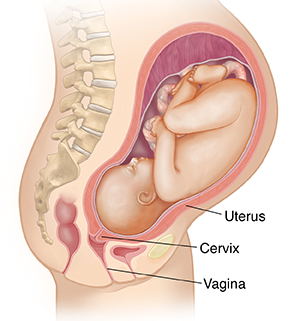Stages of Labor
Labor has 3 stages. Your healthcare provider may talk about the progress of your labor with certain words. One of these is your baby’s position. Another is your baby’s station. And the effacement and dilation of your cervix will be noted. Read below to learn about these terms and the 3 stages of labor.

Your baby moves into position
Position is your baby’s placement in your uterus. Your baby may be facing left or right. They may be headfirst or feetfirst. Station refers to how far your baby has moved down into your pelvic cavity.
First stage of labor
During the first stage of labor, contractions of the uterus help your cervix thin (efface). They also help it widen (dilate). This will help your baby pass through the vagina (birth canal). At first your contractions won't come that often or last that long. But as time passes, they will come more often, they may be more painful, and they will last longer. They will last about 30 to 60 seconds each. The first stage of labor lasts until the cervix is fully dilated.
Second stage of labor
When your cervix is fully dilated, the second stage of labor begins. In this stage, you will have stronger contractions of your uterus that will help your baby move down the birth canal. They may happen every 2 to 5 minutes. They may last from 45 to 90 seconds each. Your healthcare provider will ask you to push with each contraction. Try to rest between the contractions if you can. Your baby is delivered at the end of this stage of labor.
Third stage of labor
The third stage of labor comes after your baby is born. This is when the afterbirth (placenta) comes out of your uterus. Your uterus will continue to contract. But the contractions are much milder than before.
Online Medical Reviewer:
Donna Freeborn PhD CNM FNP
Online Medical Reviewer:
Heather M Trevino BSN RNC
Online Medical Reviewer:
Irina Burd MD PhD
Date Last Reviewed:
12/1/2022
© 2000-2025 The StayWell Company, LLC. All rights reserved. This information is not intended as a substitute for professional medical care. Always follow your healthcare professional's instructions.